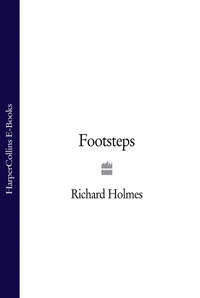
Полная версия
Sidetracks
Nodier’s support was influential, for as the eccentric librarian of the Arsenal, and the intimate of Hugo and Sainte-Beuve, his flights of fancy were closely observed by Parisian intellectuals. Deburau and the pantomime soon gained a kind of cult following. The sharp young critic on the Journal des Débats, Jules Janin, headed it with a racy two-volume Histoire du Théâtre à Quatre Sous (1832), proclaiming the classical theatre dead and wildly panegyrizing the Funambules. It was complete with commissioned portraits of Deburau, and a fictionalized account of his early career, including a discussion supposed to have been held with Napoleon before Waterloo on the problems of French drama; and a lawsuit against the theatre management involving an impious toadstool said to have sprouted in the great clown’s dressing-room.
The long-haired poets Gautier and Nerval, then both in their twenties, attended the Funambules so regularly that whenever Pierrot carried out one of his ritual abductions of jam-tarts or pies, a salutation of pastries would fly up to greet them where they sat at their posts in the front-of-house box. Many other writers and feuilletonistes later came to watch the pantomime, and those who have left records include Baudelaire, Champfleury, Alphonse Karr and George Sand.
But Gautier’s summary is perhaps the best: ‘The pantomime is the real comédie humaine; and even though it does not employ two thousand characters like Balzac’s, it is none the less complete for that. It embraces everything in four or five type-parts. Cassandra represents the family; Columbine the ideal woman or the dream pursued, the flower of youth and beauty; Arlequin with his monkey’s snout and snake-like body, his patchwork and his shower of spangles, represents Love, Wit, Impulse, Audacity, and all that glitters in vice or virtue; while Pierrot, poor haggard, pallid Pierrot in his glimmering draperies, always hungry and always beaten, is the antique slave and the modern proletarian, the pariah, the helpless and disinherited being, who witnesses the orgies and follies of his masters with mournful and yet cunning eyes.’
At the Funambules, Deburau began to give a peculiar and startling authority to the Pierrot, that être passif et déshérité. Partly this came from the conditions under which he played. The theatre, an erstwhile circus of performing dogs, Les Chiens Savants, was situated on the ancient boulevard du Temple, at the heart of the popular revolutionary quarter of Paris, between the market of Les Halles and the faubourg Saint Antoine. The canaille which crowded along the iron balustrade of the paradis – the gods, with its famous 4-sous seats – were the roughest, rowdiest, most unpredictable audience in Paris. Nerval recalled that to use a lorgnette in their presence was to incite a riot.
But it was just this audience that Deburau dominated. He did it, said George Sand, simply by expressing their own feelings. Moreover he did it in total silence. For in Deburau’s masterly hands, Pierrot had become an entirely silent mime.
Originally, this silence had a political cause. Throughout its existence between 1816 and 1862, the Funambules never received a government licence to perform speaking plays, as these were regarded, in the circumstances, as subversive of morality, law and order. Instead it confined itself to a spectacular show of tightrope walking, tumbling, quick-change, flying traps, dancing, slapstick and popular music, based on the pantomime plots of the traditional harlequinade. In place of dialogue, it developed rather more visual and violent methods of exchanging ideas and emotions. There were three specialities: cascades, highly complex, balletic fights with clubs, punches and the celebrated leaping pied au cul – or kick up the arse – which the tall, muscular Deburau excelled in. Then the sauts, startling and often perilous leaps up and down counterweighted trapdoors. And finally trucs, bizarre instantaneous changes of scenery or stage-prop, so that a sheltering wardrobe might become a ravenous whale, or a cooling icecream – for Pierrot – a spluttering Roman candle.
Moving calmly, almost sardonically, through this stylized, rather brutal form of ‘English’ pantomime, the long pale figure of Deburau gradually became the dominating genius of the theatre. The White Clown came into his own kingdom. The extraordinary, hypnotic power of the blanched face, with mournful eyes and derisive lips thrown into vivid relief, gave Deburau a dramatic instrument infinitely more subtle than Arlequin’s mask and spangles, or Columbine’s skirts and prettiness. Moreover, the taciturn Bohemian revealed an astonishing inventiveness of gesture and grimace, an entire argot of winks, sneers, nods, gapes, twinkles and guffaws. The paradis hung upon his face.
George Sand wrote that along the seething balustrade an almost studious concentration would appear, in row upon row of cupped chins and gaping mouths: ‘you really feel he is speaking, you could write down all his bons mots, all his caustic repartee, all his eloquent apologies. When the machinists make a noise backstage, the public, frightened of losing a single word of their Pierrot, howl “Silence in the wings”, and he thanks them …’
Increasingly, Deburau instilled Pierrot with his own personality: mocking, subtly malicious, charming and yet bitter, perhaps even menacing. He removed the buffoon ruff of the Commedia clown, since it obscured his face in the lurid ramp-lights, and replaced Gilles’s floppy hat with the severe black skullcap which further offset the white of his flour, and which henceforth became an obligatory part of the Parisian Pierrot’s costume. More and more he played over the heads of the other characters, directly to his audience, assuming their complicity in his schemes, nonchalant, powerfully reserved. In some pantomimes it was now he, and not the wigged Arlequin, who clasped Columbine’s waist in the traditional finale of flaring orange Bengal Flames.
By 1835, Deburau was undisputed master of the Funambules stage. His salary stood at 200 francs a month, and he had remarried. His second wife was the pretty, twenty-year-old daughter of a prosperous artisan; Deburau was thirty-nine, and his illegitimate son, Charles, from a previous liaison, was seven. He was an established professional man. At the theatre he played dominoes in his dressing-room, or criticized the other actors’ improvisations from the wings. When Placide, the old comedian who had played Cassandra, came to retire, he was presented with a pair of silver candlesticks at the final curtain, and burst into tears. The cast gathered round and the audience shook with emotional applause: then suddenly Pierrot advanced with a huge bathsponge and mopped disapprovingly at an imaginary puddle round Cassandra’s feet, thus instantly drawing laughter and then applause back to himself.
Gautier recalled sadly: ‘With Deburau the role of Pierrot grew and expanded until he finished by occupying the whole piece and distorting his own nature till its origins were almost lost. Beneath the flour and smock of the illustrious Bohemian, Pierrot took on masterful airs and inappropriate aplomb. He still delivered his kicks but he received none in return. Arlequin scarcely dared dust his shoulders with the bat, and Cassandra thought twice before landing a clout. He kissed Columbine and wrapped his arm round her waist like a seducer from the Comic Opera. He directed the action just as it suited him, and arrived at a height of insolence and daring that seemed to threaten even his own good genius …’
For one teenage spectator, Henri Rivière, there were openly sadistic moments in Deburau’s weird by-play with the paradis. Much later he formed his impressions into a brilliant first novella, entitled lightly Pierrot. ‘The audience would not have been entirely surprised if the bottle which he gave Cassandra marked “laudanum”, had really contained poison; or if, when he pretended to shave him on stage, instead of merely making Cassandra shudder with a touch of the cold razor, he had actually opened his throat from ear to ear …’
It happened, finally, in 1836, in the spring. Pierrot killed a man. Or rather, Deburau did.
The transcripts of the trial have survived, and for the first and last time Pierrot stands forth and speaks to his public. It is a moment of acute human insight, heralded in that curious way by Watteau’s unmasking of the White Clown a century before. On the surface the case was straightforward enough. Evidence was brought before the Assize to show that Deburau and his new wife had been out walking one sunny April afternoon in the suburb of Bagnolet. They were followed by a young apprentice called Nicholas Vielin, who unaccountably began to hurl taunts and insults at them: ‘Eh, Pierrot! Eh Paillasse, méchant paillasse, te voilà avec ta margot, ta putain!’ Vielin pursued them along the streets for some time, shouting obscenities at the tall clown. Deburau remained obstinately and ominously silent. Then at last, in a sudden access of rage, he turned, strode back up the road and struck a single blow with his cane. The apprentice collapsed instantly on the cobbles, with a deep wound over his left temple. He died later that evening. He was seventeen.
Deburau, with his narrow ironic face, and quick blue eyes, came pale and weeping to the witness box. He wore a black suit and waistcoat. He gave his evidence with soft, precise assurance, in a court packed with theatregoers and fashionable ladies.
President of the court: How were you holding your walking-stick?
Accused: By the middle.
President: With which end of it did you strike?
Accused: The small end.
President: What was your intention of making use of your cane?
Accused: I repeat, I had no intention of striking at all.
That crucial evidence regarding the holding of the stick was not pursued. Other damaging evidence was turned adroitly aside.
President: Once you realized the victim had died from the blow sustained, did you not instantly exclaim, ‘If he’s dead, too bad for him. When I’m in a rage, I don’t know myself?’
Accused: No Monsieur. That would not have been possible, since I did not know the young man was dead until the following day.
That non-sequitur was not picked up either.
But perhaps the most telling piece of character evidence came quite by chance, towards the end of the case, in the statement of a defence witness, a Monsieur Sartelet, obviously a man of some education. ‘I then advised Monsieur Deburau to take my address, since I might be of use to him in the affair. I added that it was happy for him I had witnessed the scene, since I could provide a true account of the facts. He replied, “Ah Monsieur! It is happy for me – but unhappy too. For had you not been there, I would have continued to support those insults in silence. But seeing you there, I could no longer bear the humiliation of being insulted before onlookers any more; and so the unhappy event took place.” (Gasps in court.)’
That surely was the evidence of the White Clown himself, the evidence of centuries.
The judge summed up the case favourably to Deburau. Young Vielin had been the aggressor, the provocation had been persistent and extreme; the death resulting from the blow was accidental. The jury returned a verdict of not guilty. Pierrot received an unconditional discharge and returned to the Funambules.
Yet Pierrot’s trial was full of macabre resonances that escaped neither the canaille, nor the literary world. Not least was the revelation that Vielin had been a regular follower of Deburau’s from the paradis, and discussed his performances passionately over the supper-table with his apprentice-master. As Alphonse Karr wrote in Nerval’s theatrical magazine, Le Monde Dramatique:
‘Before the fame brought by Janin’s book, Deburau would never have considered himself insulted. He would have pulled a grimace at his mockers and made them laugh … but instead of that, Deburau, who has never been seen white-faced except for his flour, went white-faced with anger; and with a stroke of his cane he killed a peasant boy that he had probably nearly killed on ten previous occasions with laughter … Deburau has become tragic, while murder has become a farce.’
Deburau himself could hardly avoid making the transfer between the real and the stage world. The theatrical historian Paul Hugounet later published what he claimed was a letter of Deburau at this time: ‘I can’t touch a stick any more without burning my fingers … whatever I do that death will always come between me and my public. Whenever I twirl a slapstick on stage against the make-believe assailants the spectators will think of Pierrot assassin and that will turn their laughter into ice.’
Something irrevocable had indeed occurred. Poor Pierrot had killed his fellow man, his brother, his child, his mocker. The White Clown had encountered Death. Deburau had brought a tragic presence to the role. The evolution of Pierrot’s dramatic character had made one more turn in the folk memory, and gathered one more layer of historic symbolism. The naïve flour-face, the mischievous moon-face, now also contained the deathly marble-face: white with anger, white with shock, black with knowledge. Through pride perhaps, very human pride, Pierrot had lost his innocence.
The full consequences of this are a matter of theatrical, literary and perhaps psychological history. The 1840s saw the sudden development of an entire pantomime of death, more conscious and more literary, heavy with political and moral prophecy. The Marchand d’habits (1842) in which Pierrot kills an old-clothes merchant in order to enter a society ball, gradually became Deburau’s signature piece, brilliantly analysed by Gautier and a century later superbly mimed by Jean-Louis Barrault in Marcel Carné’s celebration of the Funambules, Les Enfants du Paradis (1944). The Marchand d’habits was followed by Pierrot, Valet de la Mort (1846), Pierrot Posthume (1850), and many similar black pantomimes. Nerval wrote thoughtfully, and perhaps autobiographically, of Pierrot playing music in the halls of hell. Baudelaire produced his strange reflections on the comique féroce in a classic essay The Soul of Laughter (1855); and George Sand’s stage-struck son, Maurice, turned back to Pierrot’s pre-lapsarian days in the first authoritative history of the Commedia dell’Arte (1860).
But few of these high affairs concerned Deburau then, or need concern us now. For this is simply one story of the White Faced Clown as it happened in Paris. To imagine that Deburau’s trial seriously affected his popularity would be to misunderstand his relations with the paradis. On the contrary: six months after his acquittal, Deburau signed a new ten-year contract with the management for an unprecedented fee of 250 francs a month with a 6 per cent pension scheme. He continued to dominate the stage for another nine years at the Funambules, though increasingly racked by asthma, that most psychosomatic of diseases. Accounts tell of him leaning in the wings against the woodland scenery flaps, beating his left side with his fist and gasping for air.
In February 1845, his fiftieth year, Deburau struck the back of his head badly while plunging down one of the spring-traps to the troisième dessous, traditionally associated with Hell in the theatrical world. He replied to George Sand’s anxious inquiry on this occasion with his old flourish: ‘I do not know in what terms to express my appreciation. My pen is like my voice on stage, but my heart is like my face.’ The asthma gained relentlessly on him, and on 17 June 1846, Deburau died at three in the morning.
The young Jules Champfleury had witnessed his last night at the Funambules. They were playing the Noces de Pierrot. At the final curtain it was Deburau’s turn to let fall a single tear which traced its dark line down the white enfariné. He left the theatre at midnight by the little side door into the rue Fossés-du-Temple, the white carnation of Pierrot’s wedding feast pinned bravely to his dark lapel.
INSIDE THE TOWER
A radio-drama based on the life of the poet Gérard de Nerval. All Nerval’s speeches are drawn from his own essays, letters and journals.
(fade in radiophonic music) HOLMES In 1855 Paris suffered a bitterly cold winter. During most of January the city lay under thick snow. At night temperatures dropped below minus ten degrees centigrade. The gas-lamps glowed in the streets with a dull, blue flame. The horse-drawn omnibuses jammed in the icy ruts of the boulevard, and the café windows were opaque with frost. Down by the Seine, the washerwomen’s sheets hung rigidly over the side of the laundry barges, and the river turned to ice under the Pont Neuf and the Pont Saint Michel. The wind blew cruelly through the cobbled back-streets. The beggars said the sun had died.(fade in over music the sound of wind; then muffled street noises, carriage wheels, coughing, footsteps crunching on snow, muffled swearing in French …) EYE WITNESS I suppose it was about six-thirty in the morning, Friday 26th January. I was on my way to work across the Place du Châtelet, when I spotted a man in black uniform and a couple of policemen hurrying down a side-street. The beginning of the rue de la Tuerie was nothing but empty, boarded-up houses, but after a few steps there was the blackened shop of a key-cutter on the left, with a sign, shaped like a huge key, standing out from the wall overhead against the frosty, snow-laden sky. Further on, on the other side, was the entrance to a narrow iron flight of steps, one of those street staircases which begins with four steep steps down onto a sort of iron landing running across the width of the alley. At the bottom level the steps lead into a sordid alley which disappeared at the far end into a labyrinth of filthy back-streets. It was into this foul alleyway, known officially as the rue de la Vieille-Lanterne, I saw a man in black with two policemen going purposefully. I followed them. The cobbles were covered in thick ice, and the iron banisters were loose in several places. At the bottom of the staircase I witnessed a grim scene. A man’s body was stretched out in the alley, his head resting on the last step, and his feet sticking into the gutter of a sewage pipe that came out of the alley-wall beneath the iron landing. They had just cut him down from the bars of a low window, in the cellar-wall above the bottom steps, from which he had hanged himself … The man in black turned out to be the commissioner of police.(water, echoing footsteps and voices, the slap of wet clothes on marble …) MORTUARY Slab number 14. Twenty-sixth January 1855. ASSISTANT Reception time: nine-thirty a.m. Sex: masculine. Age: forty-seven. Place of birth: Paris, Seine. Civil status: bachelor. Clothes and possessions: one black jacket; two calico shirts; two flannel waistcoats; one pair pale-grey trousers; one pair patent-leather shoes; one pair socks – red cotton (fade) … (fade in radiophonic music) POLICECOMMISSIONER Labrunie, Gérard. Also known as Gérard de Nerval, man of letters. Temporary address at the Hotel de Normandie, 13 rue des Bons-Enfants. A case of suicide by strangulation. This morning at approximately seven-thirty a.m. the deceased was found hanging from the bars of a locksmith’s shop in the rue de la Vieille-Lanterne. He had hanged himself with a length of sash-cord; the body was attached to the bars by means of the said cord. There were no signs of violence on the corpse. MAXIME DU CAMP Very early on Friday morning I received a message from Théophile Gautier informing me that Gérard de Nerval had been found hung … They’d sent for Gautier and Arsène Houssaye to confirm the identification. Gautier was apparently moved to tears; he had a long-standing affection for Gérard. It was easy for me to see the body in the mortuary. Poor Gérard was laid out flat on his back, his eyes shut, and his tongue just slightly protruding between parted lips. His fingers were clenched inwards on his palms, but his face was calm. His head was fractionally twisted on to his left shoulder-blade, and the tips of his feet were turned abnormally outwards. There was no trace of violence, no bruising, no contusions. Only, around the neck, there ran a thin line – more brown, as I remember, than red – which bore witness to the pressure of the cord, that piece of kitchen-cord which Gérard had shown me but six days previously – and which in his madness, he took for a seventeenth-century ladies’ dress-cord, no less than the actual dress-cord of Madame de Maintenon!(tolling bell effect: radiophonics) HOLMES Gérard’s funeral took place on the 30th January, and a mass was said for him in a side chapel of Notre Dame. In order to obtain permission for him to be buried in consecrated ground at Père Lachaise cemetery, a special application was made to the Archbishop of Paris. Suicide, when committed while ‘of unsound mind’, does not cut the victim off from the consolations of Mother Church.(monks’ choir singing the ‘Dies Irae’ in Gregorian chant. In the background the sound of digging, and wind blowing. Over this the scrape of a quill pen on paper and the voice of …) DR EMILE My Lord Bishop: M. Labrunie, Gérard de BLANCHE Nerval, was suffering from extreme fits of mental alienation, which seized him on repeated occasions during these last few years, and for which he received treatment from both my father and myself, Dr Emile Blanche, in this institution … Though M. de Nerval was not ill enough to be confined in a mental asylum against his will, yet in my considered opinion his state of mind had not been healthy or normal for a long time previously. He believed he had the same powers of imagination, and the same aptitude for work, as he had in the old days, and he expected to support himself as before on the income from his writing. Certainly he worked harder than ever, but one may feel that he was disappointed in his hopes, perhaps. His natural independence and pride of character prevented him from accepting anything in the way of aid, from even his best-tried friends. As a result of these mental – or moral – pressures, his reason was driven further and further astray; and above all this was because he now saw his madness face to face. I therefore have no hesitation in declaring, my Lord Bishop, that it was certainly in an extreme fit of madness that M. Gérard de Nerval put an end to his days.(gradually fade out sound of the plainchant, the digging, and finally the wind, during the next voice-over. Towards the end, radiophonics reappear) MAXIME DU CAMP He was mad, though it was an intermittent kind of madness, which in its moments of calm left him with a personality both gentle and original, and a mode of life that was full of oddities. But when his state became critical, he was a danger both to himself and those around him, and he would be carried off to Passy, to the mental hospital in the old town house of the Duc de Penthièvre, run by Dr Emile Blanche. These fits would either depress him to the point of coma, or else excite him to the pitch of fury; but they rarely endured for more than six months at a time. He would emerge from them slowly, like someone only half-awake and still under the impression of a vivid dream. I often used to go and visit him in the asylum when he was recovering. He said to me on one occasion: It’s so kind of you to come, Du Camp: you know our poor Dr Blanche is mad. He thinks he is running a mental hospital, and we all have to pretend to be mental patients in order to calm him down. I wonder if you could stand in for me a while, because I have to go over to Chantilly tomorrow morning to marry Mme de Feuchères. You will recall that Mme de Feuchères was the mistress of the last prince of the house of Condé, who hanged himself from a window with a silk handkerchief.(music starts faintly)








